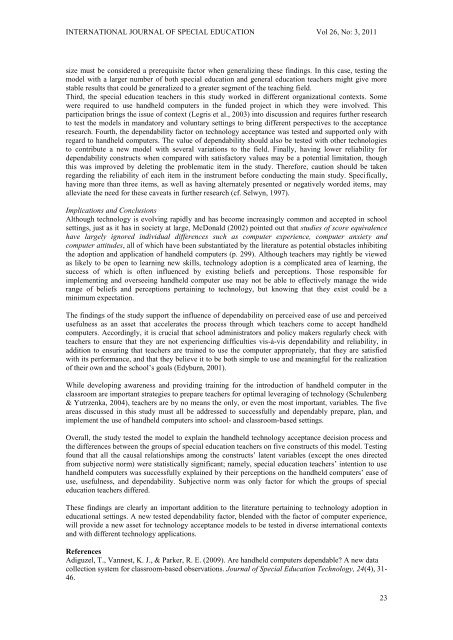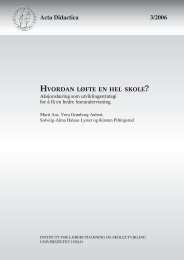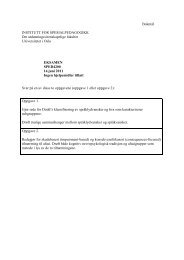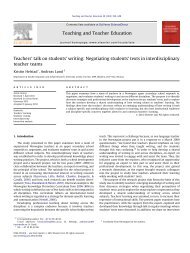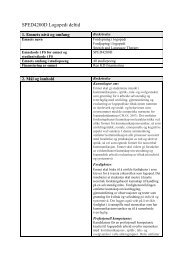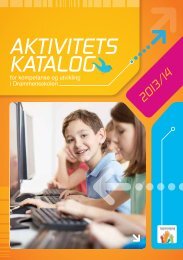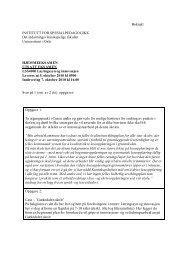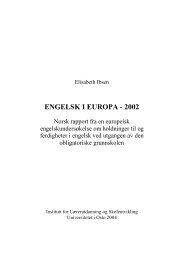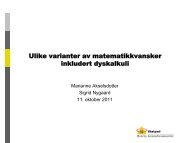International Journal Special Education
International Journal Special Education
International Journal Special Education
You also want an ePaper? Increase the reach of your titles
YUMPU automatically turns print PDFs into web optimized ePapers that Google loves.
INTERNATIONAL JOURNAL OF SPECIAL EDUCATION Vol 26, No: 3, 2011size must be considered a prerequisite factor when generalizing these findings. In this case, testing themodel with a larger number of both special education and general education teachers might give morestable results that could be generalized to a greater segment of the teaching field.Third, the special education teachers in this study worked in different organizational contexts. Somewere required to use handheld computers in the funded project in which they were involved. Thisparticipation brings the issue of context (Legris et al., 2003) into discussion and requires further researchto test the models in mandatory and voluntary settings to bring different perspectives to the acceptanceresearch. Fourth, the dependability factor on technology acceptance was tested and supported only withregard to handheld computers. The value of dependability should also be tested with other technologiesto contribute a new model with several variations to the field. Finally, having lower reliability fordependability constructs when compared with satisfactory values may be a potential limitation, thoughthis was improved by deleting the problematic item in the study. Therefore, caution should be takenregarding the reliability of each item in the instrument before conducting the main study. Specifically,having more than three items, as well as having alternately presented or negatively worded items, mayalleviate the need for these caveats in further research (cf. Selwyn, 1997).Implications and ConclusionsAlthough technology is evolving rapidly and has become increasingly common and accepted in schoolsettings, just as it has in society at large, McDonald (2002) pointed out that studies of score equivalencehave largely ignored individual differences such as computer experience, computer anxiety andcomputer attitudes, all of which have been substantiated by the literature as potential obstacles inhibitingthe adoption and application of handheld computers (p. 299). Although teachers may rightly be viewedas likely to be open to learning new skills, technology adoption is a complicated area of learning, thesuccess of which is often influenced by existing beliefs and perceptions. Those responsible forimplementing and overseeing handheld computer use may not be able to effectively manage the widerange of beliefs and perceptions pertaining to technology, but knowing that they exist could be aminimum expectation.The findings of the study support the influence of dependability on perceived ease of use and perceivedusefulness as an asset that accelerates the process through which teachers come to accept handheldcomputers. Accordingly, it is crucial that school administrators and policy makers regularly check withteachers to ensure that they are not experiencing difficulties vis-à-vis dependability and reliability, inaddition to ensuring that teachers are trained to use the computer appropriately, that they are satisfiedwith its performance, and that they believe it to be both simple to use and meaningful for the realizationof their own and the school’s goals (Edyburn, 2001).While developing awareness and providing training for the introduction of handheld computer in theclassroom are important strategies to prepare teachers for optimal leveraging of technology (Schulenberg& Yutrzenka, 2004), teachers are by no means the only, or even the most important, variables. The fiveareas discussed in this study must all be addressed to successfully and dependably prepare, plan, andimplement the use of handheld computers into school- and classroom-based settings.Overall, the study tested the model to explain the handheld technology acceptance decision process andthe differences between the groups of special education teachers on five constructs of this model. Testingfound that all the causal relationships among the constructs’ latent variables (except the ones directedfrom subjective norm) were statistically significant; namely, special education teachers’ intention to usehandheld computers was successfully explained by their perceptions on the handheld computers’ ease ofuse, usefulness, and dependability. Subjective norm was only factor for which the groups of specialeducation teachers differed.These findings are clearly an important addition to the literature pertaining to technology adoption ineducational settings. A new tested dependability factor, blended with the factor of computer experience,will provide a new asset for technology acceptance models to be tested in diverse international contextsand with different technology applications.ReferencesAdiguzel, T., Vannest, K. J., & Parker, R. E. (2009). Are handheld computers dependable? A new datacollection system for classroom-based observations. <strong>Journal</strong> of <strong>Special</strong> <strong>Education</strong> Technology, 24(4), 31-46.23


